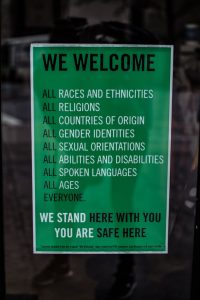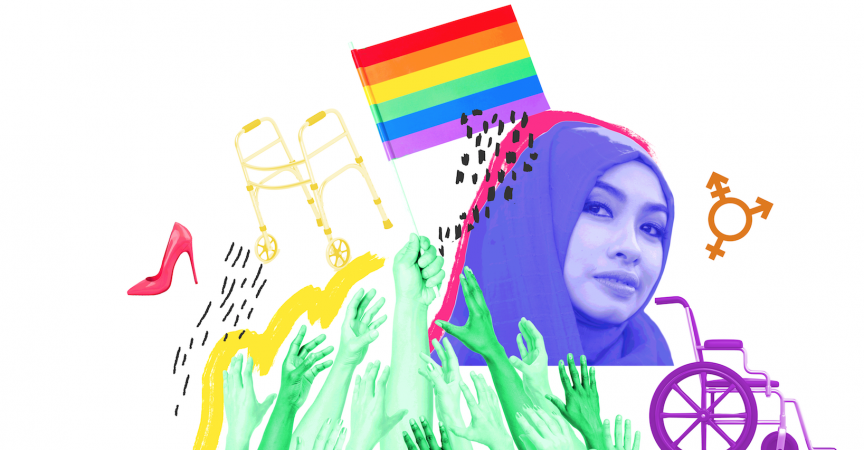Diversity & Inclusion in the Workplace
The washroom at Anh and Chi restaurant in Vancouver has been getting a lot of attention lately. It’s a gorgeous room, and it’s a finalist for this year’s Cintas Canada Best Restroom Award. It’s also gender neutral and symbolizes a deeply rooted commitment to diversity and inclusion.
This isn’t just a heartwarming anecdote; it’s the story of a smart business strategy.
Amelie Nguyen and her brother, Vincent Nguyen, took a career detour into the restaurant business eight years ago, after their father died at the age of 55. Their mother needed help to run Pho Hoang, a Vietnamese restaurant she created with her husband in 1983, a few years after arriving in Canada as refugees.
It soon became clear that Pho Hoang had reached a plateau. The family made the difficult decision to close the restaurant and completely reinvent it while preserving and building on their family’s culinary heritage. Anh and Chi (it means eldest brother and eldest sister in Vietnamese) was unveiled two years ago to rave reviews. The Main Street restaurant employs 50 people and is the kind of inclusive and busy gathering place Amelie dreamed of. A vibrant mix of cultures, languages, genders and ages.
“We wanted to make sure our restaurant is very inclusive and speaks to people intergenerationally and interculturally. We are highly committed to inclusion and social connectedness,” says Amelie, who has a background working with vulnerable communities.
Hiring and training have been pivotal to the restaurant’s transformation. “We hire for values and attitudes over skills any day,” says Amelie. “We have deep and meaningful conversations with our team members, and we’re honest and respectful about our commitment to diversity.”
Several former Pho Hoang employees, who had been part of a nearly all-Vietnamese team for many years, joined the diverse new team at Anh and Chi. “We made a point of sharing with older employees that our community has changed and we need to change too. We value their loyalty and the fact that they stayed with us,” says Amelie.
A focus on cross-cultural communication also smoothed the transition. For example, Vietnamese people tend not to respond directly with “yes” or “no,” or may avoid eye contact out of respect, notes Amelie.
And the gender-neutral bathroom?
 “The positive feedback has been incredible—people saying they haven’t been to Anh and Chi but now they look forward to visiting us.”
“The positive feedback has been incredible—people saying they haven’t been to Anh and Chi but now they look forward to visiting us.”
Restaurants across Canada increasingly recognize the importance of diversity and inclusion—whether it’s providing more opportunities for people with disabilities, seeking out racially and culturally diverse candidates, creating a safe and welcoming environment for the LGBTQ community or striving for gender balance.
Those who succeed understand there are two parts to the equation. It’s been said that diversity is the mix and inclusion is making the mix work. It doesn’t have to cost a lot, and the return on investment is huge.
Cyrus Cooper, professor and program coordinator of the Hotel, Resort and Restaurant Management graduate certificate program at Centennial College in Toronto, recently led a Restaurants Canada webinar on creating positive and inclusive workplaces. “Inclusion is good business. It’s simple, and it can be done within your workplace,” he states.
Getting the right team in place (the mix) is important, but so is creating the right work environment (making the mix work). “Be nice, be approachable, follow the Golden Rule and do unto others as you would want done unto yourself,” advises Cooper. “When you listen, you provide an opportunity for people to grow, develop and participate in the actual process. That’s when we really see dividends.”
There’s plenty of research to back that up. Numerous studies show that diversity and inclusion result in less employee turnover, higher profits and more innovation. For example, a 2014 study by the Multicultural Foodservice & Hospitality Alliance (cited in Restaurants Canada’s “How to Create a Positive and Inclusive Workplace” guide) showed that companies with diversity and inclusion strategies reported 15 per cent -19 per cent lower turnover in restaurant hourly employees and 7 per cent lower turnover in restaurant management employees.
A 2018 McKinsey & Company study, Delivering through Diversity, looked at the profitability of more than 1,000 companies across 12 countries, and makes a compelling case:
- Companies in the top quartile for gender diversity on executive teams were 21% more likely to outperform the competition on profitability in terms of earnings before interest and taxes (EBIT)
- For cultural and ethnic diversity the number rises to 33 per cent likelihood of outperformance on EBIT margin
- Companies in the bottom quartile for both gender and ethnic/cultural diversity were 29% less likely to achieve above-average profitability
- Multiple studies also show that diverse teams have a measurable advantage over homogenous teams. They’re better at focusing on facts, they make better decisions and they’re more innovative.
“When you have a diverse workforce you perform better. You have more perspectives, you have different people with different experiences and you’re able to solve problems more effectively. Secondly, it’s just the right thing to do. Your workforce should reflect the diversity of the community that you’re in, and if doesn’t it suggests that there might be some kind of bias somewhere along the process.”- Hadiya Roderique, a lawyer, journalist and researcher in organizational behaviour
Roderique’s 2017 essay for The Globe and Mail, “Black on Bay Street,” sparked a national discussion about the barriers to inclusion that still exist in many workplaces. When the business case for diversity and inclusion is so strong, why is it still an issue?
“We are social animals, and we tend to gravitate towards others who are like us,”. “We’re asking people to do something that’s difficult. Don’t choose someone who’s just like you. Look for and acknowledge the value in someone who’s different from yourself.”
Actively seeking diversity is the first step; embracing the new dynamic is the next. Having diverse voices around the table will shake up your decision-making process, and it’s change for the better. “We tend to think that easiness is a sign that we’re on the right track, that we’re making the right decision,” Roderique says. “When actually, when you’re all in agreement that means you’re not looking at different perspectives. You’re not doing the things that would make the process more challenging. It’s going through the process of that challenge that makes you make a better decision.”
One of the first steps to creating and sustaining a workplace where everyone feels welcome, included and respected is acknowledging that certain groups face systemic barriers that others don’t.
“Exposure to people who are different from us has been shown to change the way we think and open your eyes to some of these differences,” says Roderique. “There are people who don’t realize that some things are monumentally harder for some people than others. You don’t even realize what happens to some other people if you don’t surround yourself with diverse people.”
Centennial College’s Cyrus Cooper sees Canada’s cultural diversity as a strategic advantage for restaurateurs. “We pride ourselves on our cultural diversity in Canada. We have to cherish it and take it into our advantage—use it to compete with other countries and attract talent. People bring amazing qualities to the table.”
Like Amelie Nguyen of Anh and Chi, Cooper believes in hiring from diverse groups and focusing on the candidate’s potential. “Skills are skills,” he says, “but potential leads to greatness. The restaurants that are successful now are the restaurants that find new ways to attract talent, retain that talent, grow that talent and show opportunity for that talent to one day be the future leaders of tomorrow.”
Sodexo Canada Ltd., a leading provider of integrated food and facilities management services, has made tremendous strides in this area. The company was recently named one of Canada’s Best Diversity Employers by Mediacorp for the fifth straight year. Over 65 per cent of Sodexo employees are women; 33 per cent are visible minorities; 5.5 per cent are Indigenous; 3.2 per cent have a disability; and 87 per cent of their Canadian management teams are gender balanced.
“It’s not a huge investment. It’s the will of the leadership,” says Katherine Power, Sodexo Canada’s vice president of communications and corporate affairs. “It’s around the culture you create, where people are safe to be themselves and safe to speak up. It’s not expensive; it’s not time-consuming. It’s a mindset and a commitment.”
It’s also a competitive advantage in today’s marketplace. Employee surveys show that diversity and inclusion is the top driver of employee engagement and the top reason why employees join Sodexo. And, many clients choose to work with Sodexo because of their shared values around diversity and inclusion.
Power, who was volunteering and cheering on two Sodexo employees at the Special Olympics in Antigonish when we spoke by phone, says Sodexo is currently focused on hiring people with disabilities. “It’s an untapped market of qualified candidates who make amazing employees,” she says. “They are innovative, eager to work, and they bring a different perspective to the business. And it feels good! It’s a win-win strategy to do something that’s altruistic and good for business.”
Restaurants are a business like no other. In Canada, they touch the lives of 22 million customers a day, and more than one million employees. That makes diversity and inclusion all the more important and impactful in this industry.
“On the surface, restaurants are about food and drink,” says Amelie. “But social connectedness is our contribution to society. We create spaces where people feel like they belong, they are connected and they are supported.”
Taking Action
If you haven’t formalized your diversity and inclusion strategy, or it needs some fine-tuning, here’s some food for thought based on my conversations with Amelie, Hadiya, Cyrus and Katherine:
Educate yourself
Read and learn about diversity and inclusion
Restaurants Canada has published two excellent guides, specifically for the foodservice industry:
- How to Create a Positive and Inclusive Workplace
- Diversity Toolkit: Recruitment and Retention of a Diverse Workforce
Both are available in the Member Portal at RestaurantsCanada.org.
Collect qualitative and quantitative data about your employees
In addition to tracking the numbers, Hadiya Roderique suggests an anonymous survey to encourage people to talk about things they’ve experienced in the workplace, as well as exit interviews to find out why talent is leaving. “It’s hard for numbers to capture lived experiences. The numbers don’t tell you how that experience feels or what it means to someone.”
“Do your employees feel safe, secure and proud to be part of this organization? You need to ask yourself that and canvass your team,” says Cyrus Cooper.
Look for diversity in your job applicants
Are you attracting diverse candidates for your job openings? If your applicants and interviewees all look and sound the same, there may be bias in your recruitment process.
Rethink your recruitment + hiring process
Recruit from diverse sources
“If you want diversity, you need to recruit from diverse sources,” says Katherine Power. Consider posting jobs with colleges, universities, libraries and community centres. “You’re now being a participant in the community and attracting talent from all walks of life,” adds Cooper.
Remove bias from the screening process
A 2016 University of Toronto study showed that black and Asian students were twice as likely to get a call-back from an employer if they “whitened” their resumes by toning down racial identifiers such as name, education and interests. This held true even for employers with diversity statements. To counter this bias, consider anonymizing resumes, and conduct diversity and inclusion training to address any organizational issues.
Hire employees who share your values around diversity and inclusion
This can be a tough one to assess, but Amelie Nguyen has this suggestion: “Listen to how they speak about other people, how they refer to people. Some are not familiar with terms around inclusion and social connectedness, but they are warm-hearted about it. Others are not familiar and cold-hearted. You can tell the difference by listening.”
Embed diversity + inclusion in your culture
 Write it down
Write it down
This is especially important in the foodservice business, with its relatively high turnover rate. “Having things written down keeps the compass for your organization on track. Managers change, people move around. If that message leaves your organization and is not written down, you’re constantly going to be in a state of flux,” says Cooper. But, he cautions: “When you mention something once or put it on the bulletin board it goes there to wrinkle and die. When you continue to mention it and make it part of your culture, it nourishes and becomes ingrained, and you start seeing dividends.”
Talk about it
Successful companies embed diversity and inclusion in their organizational culture. “You can include D & I in your values and strategy, or put it on a poster on the wall, but if it’s not part of the culture, it doesn’t exist. We track it, we talk about it, we celebrate it. It’s part of the conversation at work on a daily basis. It’s the way we do things,” says Power. And if things go off track, deal with the situation quickly, directly and respectfully.
Walk the talk
A few years ago, Sodexo offices displayed an anti-homophobia poster that featured two male hockey players kissing. At one location employees objected and removed the poster. “Our president at the time called it out in a direct statement on his blog,” says Powers. He used the opportunity to explain why talking about diversity is important—and non-negotiable.
We wanted to make sure our restaurant is very inclusive and speaks to people intergenerationally and interculturally. We are highly committed to inclusion and social connectedness
When you listen, you provide an opportunity for people to grow, develop and participate in the actual process. That’s when we really see dividends.
Restaurants Canada Resources
Restaurants Canada and Centennial College’s Centre for Global Citizenship, Education and Inclusion recently launched a comprehensive resource for foodservice operators: How to Create a Positive and Inclusive Workplace. It covers laws, regulations and best practices in the areas of human rights, workplace health and safety, and employment standards.
The unique advantage of this “how to” guide is it covers a wide range of issues through a foodservice lens: everything from dress codes and tip pools to mental health and religious accommodation.
The guide “gives everyone working in foodservice a starting place for having conversations about how they can be more inclusive, with resources for more guidance and support,” says Restaurants Canada president Shanna Munro. “It’s also given us a great way to showcase some of the successes that businesses in our industry are having making their workplaces more inclusive so that others can follow their lead.”
The guide is part of an ongoing effort by Restaurants Canada, and its partners such as Centennial College, to help foodservice operators create positive and inclusive workplaces.
“The needs of the people we work with and the communities we serve are always evolving, so it’s incredibly important to keep these conversations going,” says Munro. In addition to hosting educational webinars, the team at Restaurants Canada is continuing to develop sections of the guide and plans to introduce certification programs to help foodservice professionals stay on top of best practices for building awareness, skills and leadership around issues of diversity, equity and inclusion.
“Together we can raise the bar for foodservice workplaces in Canada and set an example for the rest of the world,” -Shanna Munro.
Restaurants Canada members can log into the Member Portal at RestaurantsCanada.org to download the guide. Not a member? You can sign up online or contact the Member Services team at 1-800-387-5649 or membership@restaurantscanada.org, and start ramping up your diversity and inclusion strategy.









